INTRODUCTION TO THE TERRITORY
Urban Wet.Ware Guatemala City gave us an opportunity to test the potential of pairing algorithmical and biologically grown networks to analyse the interdependence of digital and biological intelligence. In this project wildlife flows in the city of Guatemala and its co-existence within the urban infrastructure is explored. Guatemala is situated in a crucial point of migration paths of numerous wildlife species. Most of them need to move seasonally to track hospitable climates as they shift across the landscape from South to North America and viceversa.
Guatemala City is located right in the middle of those pathways.
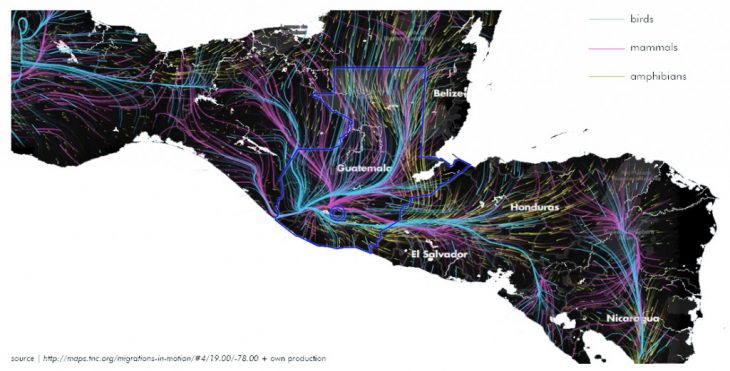
DEFORESTATION AS A PULLING FACTOR TO THE CITY
About 35% of Guatemala’s total surface area is covered in forest, down considerably from 50% in 1950 according to the Forest Carbon Partnership Initiative studies. It is projected that by 2050, there will be 66 percent of world population will live in urban area. With an ever increasing urban development which reduces the wildlife habitat, many animal and plant species have adapted to these new stresses, food sources, predators and threats in urban and suburban environments, where they already thrive in close proximity to humans.
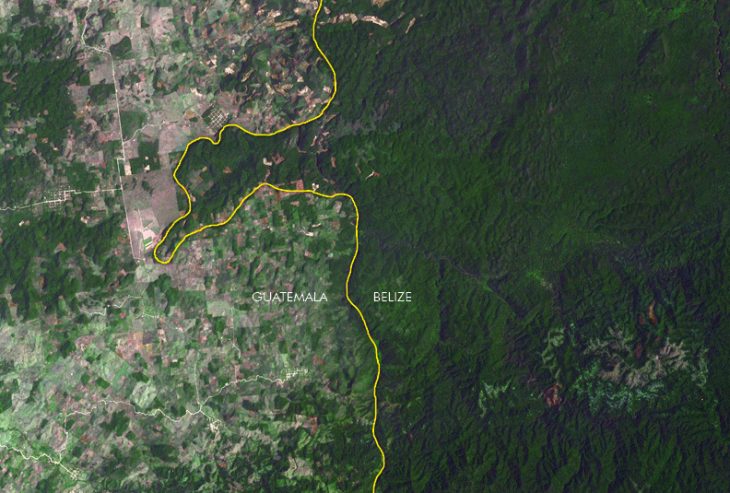
THE ANIMALS CASE STUDY
In our research, we have studied four species tracing and mapping up their trails, so to mitigate the extent of deforestation. Two animals and two birds were chosen. The rationale of selecting two birds species and two ground animals is to get a complete picture of the situation in our project’s area. The analyzing factor was the maximum altitude. Moreover, two other parameters were added according to the kind of animal. The flying distance was taken in account for the birds and the travel range was about the ground species.
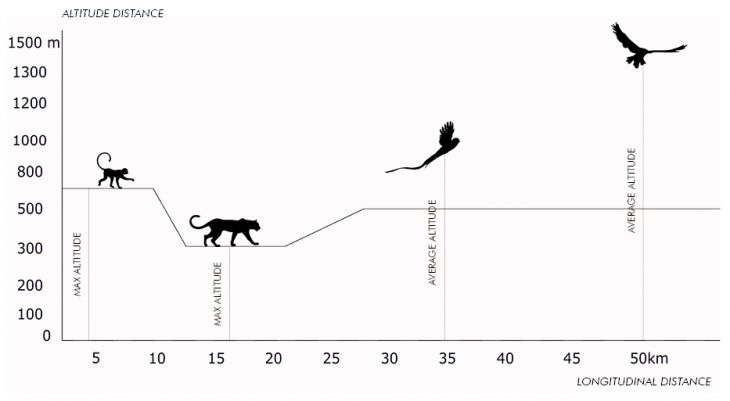
BLACK HOWLER: the day range length is widely estimated to be between 0.5 and 5 km, depending on a number of factors such as season, weather, and group composition (van Roosmalen 1985)
OCELOT: is a solitary animal that occupies a home range that can be up to 30 kmq depending on the surrounding environment
QUETZAL: they are weak fliers. However through radio telemetry studies (Powell and Bjork 1994,1995) showed that individual quetzal can transverse 35 km average during its seasonal migrations.
KING VULTURE: King vulture makes extensive use of the winds and thermal convection and orographic airflow over the mountainous terrain, they are able to glide as far as 50 km without losing if the thermals form a street.
THE FRAMEWORK
We modeled potential habitat paths for these four species using algorithmic projections with their travelling distance. Using flow lines, proximity lines and minimum paths, we plotted movement routes for each species, connecting current habitats with their projected locations under the green area intensity.

THE MAPS
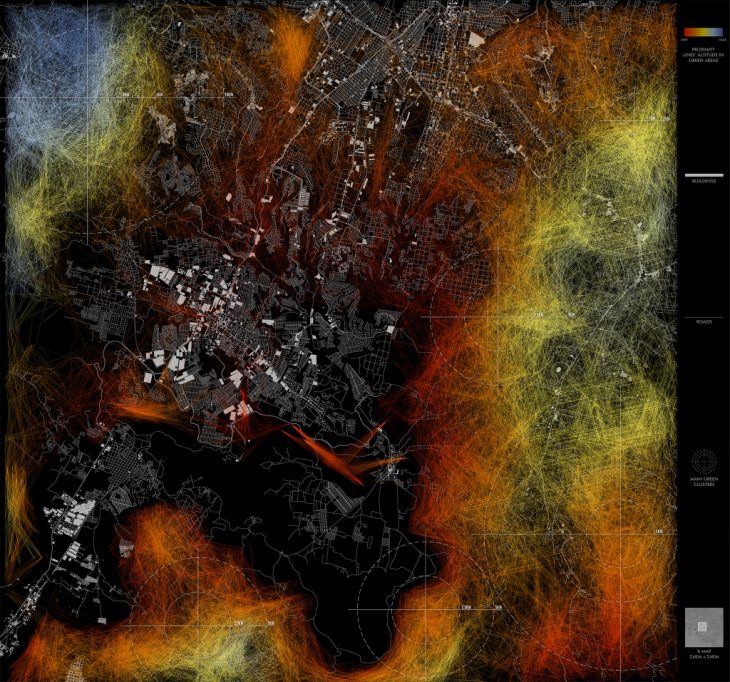 _proximity lines throughout green areas
_proximity lines throughout green areas
// lines following the green areas circles’ center
// minimum radius proximity line: 1500 m
// colour gradient blue-red as highest-lowest
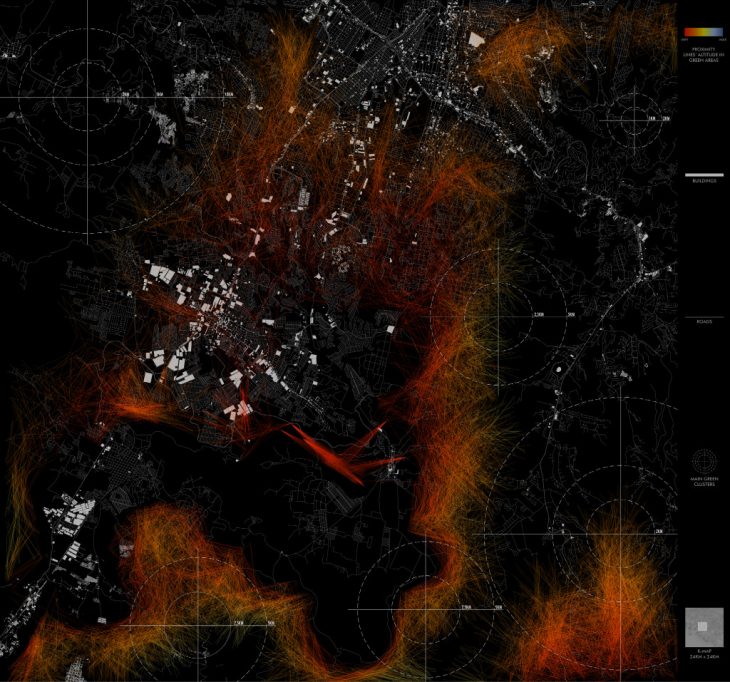 _proximity lines black howler throughout green areas
_proximity lines black howler throughout green areas
// lines following the green areas circles’ center
// minimum radius proximity line: 1500 m
// colour gradient blue-red as highest-lowest
// culling the lines over 750 m
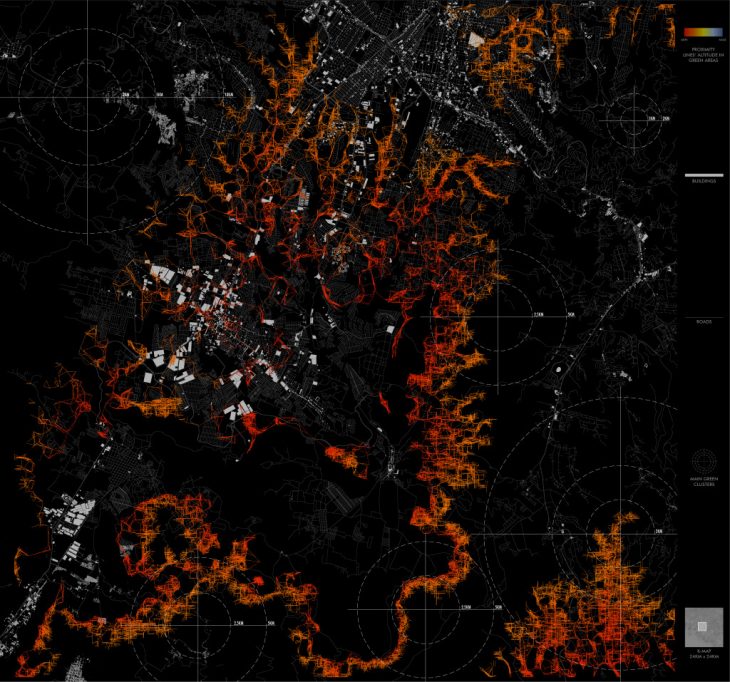 _proximity lines black howler, applying its distances and parameters
_proximity lines black howler, applying its distances and parameters
// lines following the green areas circles’ center
// minimum radius proximity line: 500 m
// colour gradient blue-red as highest-lowest
// culling the lines over 750 m
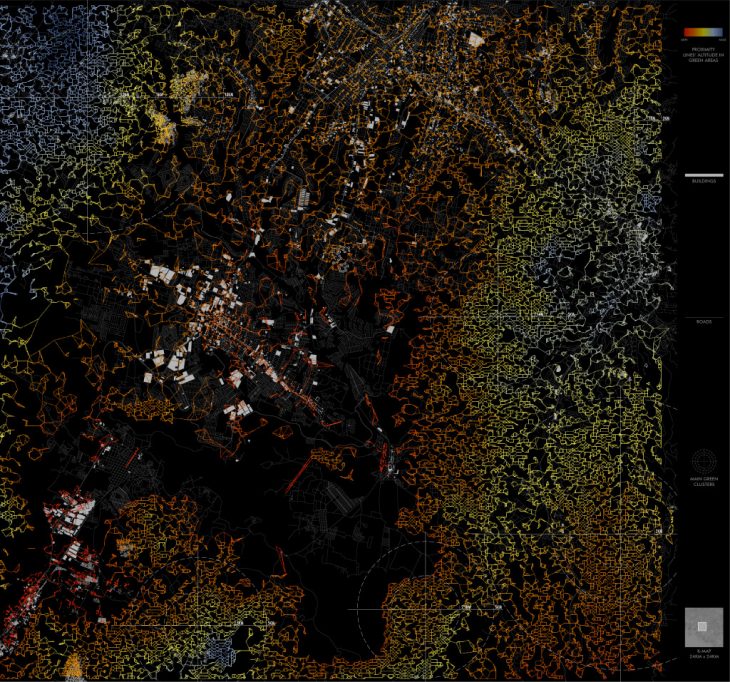 _proximity lines quetzal, applying its distances and parameters
_proximity lines quetzal, applying its distances and parameters
// lines following the green areas circles’ center and rooftops
// minimum radius proximity line: 500 m
// colour gradient blue-red as highest-lowest
// not culling any lines, since the quetzal can fly all over the project area
 _minimum path black howler (from proximity lines)
_minimum path black howler (from proximity lines)
// lines following the green areas circles’ center
// four source points for the path: the three forests around the city and the greenest point in the urban area
// culling lines with length larger than 5 km, as the daily black howler’s maximum travel distance
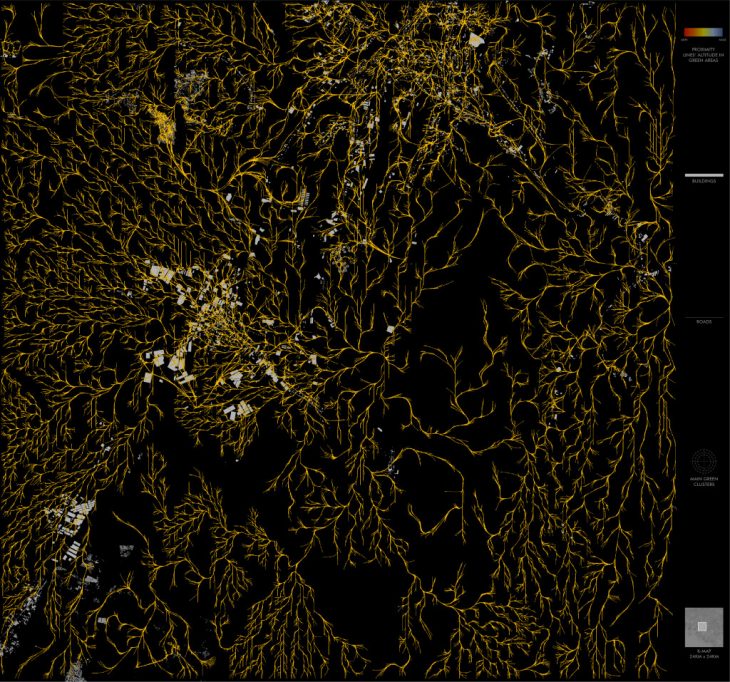 _minimum path quetzal (from proximity lines)
_minimum path quetzal (from proximity lines)
// lines following the green areas circles’ center
and the rooftops
// four source points for the path: the forests around the city
// not culling any lines, since the quetzal can fly all over the project area
THE FINAL DRAWING / URBAN COEXISTENCE
In the final drawing, both minimum paths were overlapped with the topography contours, the green areas and the human elements, such as main roads and building, in order to find the contact points among wildlife and human beings. The identity of different intersections changes according to the kind of animal. Indeed, regarding the Quetzal, as a bird, the future green rooftops will be the contact points. The black howler, as a ground animal, across the main roads; therefore, those contact points were spotted (with purple crosses in the drawing).
The intensity of that coexistence is quite clear looking at the final map, both for the black howler’s crosses, and for the bird. Indeed, the density of the Quetzal’s minimum path increase right in the urban areasas, where the building presence is higher.
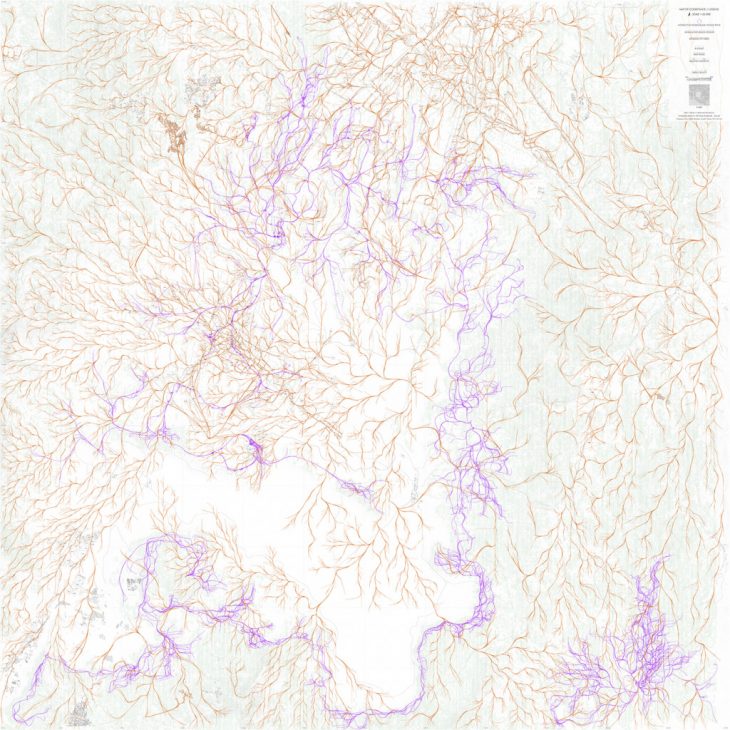 _final drawing
_final drawing
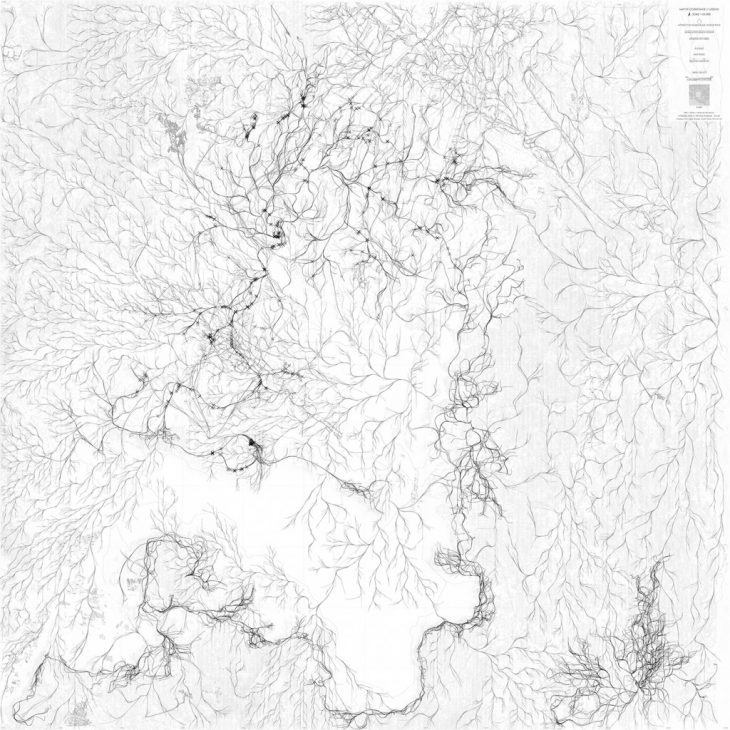 _final drawing / grey scale version
_final drawing / grey scale version
Since the urban coexistence among humans and wildlife is a topic that currently affects a lot of big cities all over the world, the importance of the research can be extended not only to the guatemalan territory, but also to larger scales. Moreover, as already mentioned in the first paragraphs, Guatemala City plays a crucial role for the migratory pathways through the Americas.
Therefore, beside the idea of the multiscalar framework’s application, the project could be useful in different contexts presenting the same issues of our case study, even if the final outcome could depend on many factors according to the wildlife and territorial features.
FRAMEWORK’S VIDEO PRESENTATION
Wildlife flows / urban coexistence is a project of IAAC, Institute for Advanced Architecture of Catalonia developed at Master in Advanced Architecture in 2019/2020 by:
Students: Francesco Polvi, Aditya Ambare, Chim Meng Lim, Dinesh K. Vellingiri
Faculty: Marco Poletto | Faculty assistant: Marios Apostolos Mouzakopoulos
